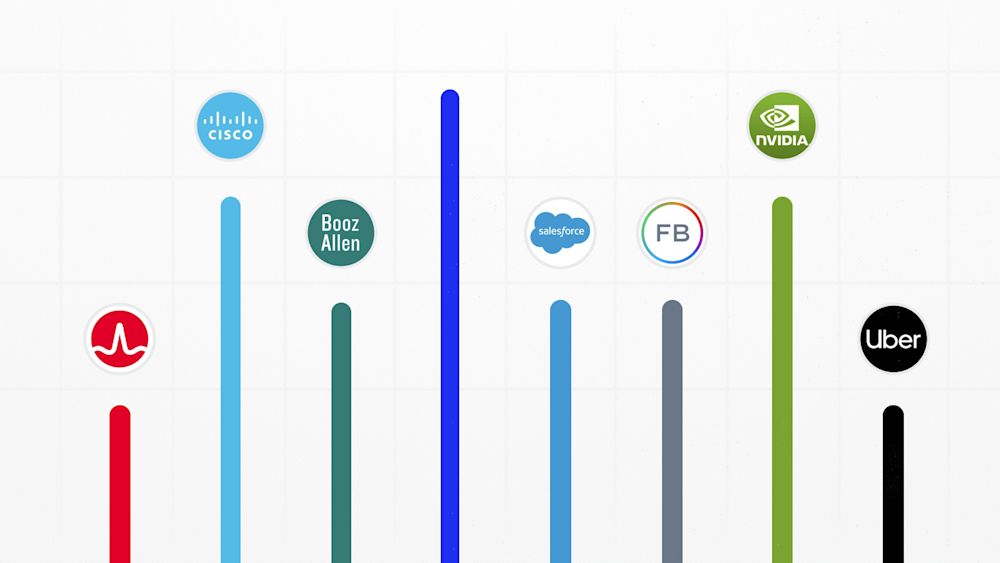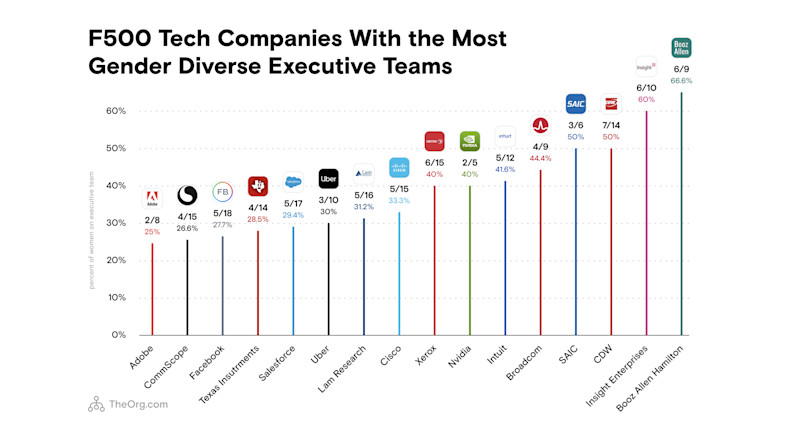- Iterate
- Meet The Team
- The Most Gender Diverse Executive Teams in Tech in 2021
The Most Gender Diverse Executive Teams in Tech in 2021
Table of contents
In recent years the representation of women in top corporate roles has been trending upwards, although from a somewhat dismal base – and even now 41 female Fortune 500 CEOs is just 41 out of 500. We’ve compiled a list of the 16 leading tech companies from the F500 with the highest percentage of women on their executive teams.

Here is our data
We’ve compiled a list of the 16 leading tech companies with the highest percentage of women on their executive teams based on leadership team data from company websites.
We’ve focused on the technology industry as a high-growth, high-value sector that, although at the forefront of innovation, has long been plagued with diversity issues.

We’ve focused on the largest public U.S. tech companies according to the Fortune 500 rankings of the largest tech companies in 2020. The Fortune 500 is seen as a microcosm of U.S. business and the diversity of its top companies are closely monitored for indicators of national progress. These companies have executive teams where women comprise 25% of more of the total C-suite positions. Below is a detailed breakdown of the data supporting our analysis, which is based on company website data as of February 5, 2021.
| Companies | Executives (Women / Total) | Share of women (%) | | :---------- | :---------- | :---------- | | Booz Allen Hamilton | 6/9 | 66.6% | | Insight Enterprises | 6/10 | 60% | | CDW | 7/14 | 50% | | SAIC | 3/6 | 50% | | Broadcom | 4/9 | 44.4% | | Intuit | 5/12 | 41.6% | | Nvidia | 2/5 | 40% | | Xerox | 6/15 | 40% | | Cisco | 5/15 | 33.3% | | Lam Research | 5/16 | 31.2% | | Uber | 3/10 | 30% | | Salesforce | 5/17 | 29.4% | | Texas Instruments | 4/14 | 28.5% | | Facebook | 5/18 | 27.7% | | CommScope | 4/15 | 26.6% | | Adobe | 2/8 | 25% |
Here are some of the key observations from our analysis of these executive teams:
Most popular roles
The most common roles for female executives are far and away chief people officer and chief human resource officer. There are 13 women who hold these titles in our analysis. The second most common title, that of chief financial officer (including one VP of corporate finance), is held by six women.
The companies with female CFOs are Insight Enterprises, with two, Intuit, NVIDIA, Salesforce and Broadcom (who has a female VP corporate finance).
It is encouraging to see an increase in women holding the CFO role, as in last year’s analysis done by The Org the majority of women in executive teams were in positions that lacked profit and loss generating responsibilities, meaning they are less likely to be promoted to CEO.
In this year’s analysis, five women work as general counsel or chief legal officer, five as chief communications officer, five as chief of marketing and sales and five run strategic growth and partnerships. Across the companies, there are more than 40 senior vice presidents, executive vice presidents and corporate vice presidents.
Least common roles
In our analysis, no women executives held the chief product or chief information officer roles, and only one was chief technology officer, Marianna Tessel of Intuit.
Other rare positions were chief operating officer, with one COO, Sheryl Sandberg at Facebook and one EVP operations, Debora Shoquist at NVIDIA.
Only two companies had diversity and inclusion executives and both were held by women, Maxine Williams at Facebook and Bo Young Lee at Uber.
Companies with women CEO
Two of the 16 companies have a woman in the CEO role; they are Nazzic Keene of SAIC and Christine Leahy of CDW. At both SAIC and CDW, women comprise 50% of the executive team, showing a strong correlation between female leadership and female representation.
Other high profile female CEOs in tech that didn’t make our list include Reshma Saujani, founder and CEO of Girls Who Code, Susan Wojcicki of YouTube, Lisa Su of AMD and Safra Catz of Oracle.
The lack of female CEOs is not surprising given the discrimination that continues to exist within hiring and promotion pipelines and the historical trend of most female executives not serving in roles with profit and loss responsibilities, such as chief operating officer or heads of business units or subsidiaries that often serve as stepping stones to the CEO role.
Companies where men outnumber women
Booz Allen Hamilton and Insight Enterprises stand out as the only companies where women make up the majority of the leadership team. Booz Allen Hamilton has six women on its nine member executive team (66.6%) and Insight Enterprises has six of ten (60%).
CDW and SAIC deserve special mention for having equal representation of women and men on the executive teams, followed not fair behind by Broadcom with 44.4%.
Shelly Cerio, SVP of HR, at NVIDIA, where women make up 40% of the executive team, told The Org creating a safe, ethical and inclusive environment was fundamental to empowering all employees to do their best work.
“Having a diverse set of voices, regardless of gender, race or religion, across all levels of our company help us make better decisions so we can stay the forefront of innovation.”
At Booz Allen Hamilton, where women comprise 66.6% of the company’s executive team, CEO Horacio Rozanski loudly promulgates the importance of fostering company diversity. Under his tenure, the company has gone from zero to five women on its 12-person board and eight of the company’s nine top executives are women or people of color.
Chief People Officer Betty Thompson told Washington Technology: “We are looking for the highest quality people and diversity is certainly a part of that. People want to see people that are like them at the top of the company and on the board.”
Leading through pandemic
In 2020, multiple women were promoted to CEO of major companies amidst the pandemic. This follows a well-documented “glass cliff” trend, where women are promoted in times of crisis and take on greater risk for failure.
This trend comes on top of the fact women are often held to higher performance standards than men and are more likely to be blamed for company failures, as laid out in McKinsey & Company research.
In June, Carol Tomé took over as CEO of UPS, and in September Linda Rendle became the CEO of Clorox. Both of these companies have played an outsized role during the pandemic, and have taken on increased risk of failure given the surge in their products’ demand. Jane Fraser also made history last year, when it was announced she would take over as CEO of Citigroup this year. It will make her the first female CEO of a major U.S. bank.
Increasingly, societal and industry pressures are forcing the hands of major companies slow to adapt their own diversity practices. Boards have been a particular focus. In 2020, Goldman Sachs announced it would not take companies public without having at least one diverse candidate on the board, and Nasdaq sought permission to require all listed companies to have at least one female-identifying board member and at least one board member LGBTQ or minority member.
“We are taking the leadership here because there has been so little action on this front and we do think it’s an important thing for us to do — to create a more inclusive capitalist society and we think this is a step forward,” Nasdaq President and CEO Adena Friedman told CNBC.
Action steps
In order to get more women into top positions it is widely recognized that cultivation pipelines into middle management and upwards need to be developed, as the “broken rung” often leaves women at entry-level positions or just above.
Also, the impetus on increasing diversity must go hand-in-hand with inclusion, whereby companies must address systemic biases around opportunities and discrimination. Amidst the pandemic, companies now have the opportunity to review and adapt their performance review criteria and productivity expectations, that are currently leading women to either fall short at work, or in their home life.
McKinsey & Company research found making work more sustainable; resetting norms around flexibility; taking a close look at performance reviews; taking steps to minimize gender bias; adjusting policies and programs to better support employees; and strengthening employee communication would all go a long way to making a more inclusive workplace that was supportive of minorities.
As the researchers highlighted, this moment requires long-term thinking, creativity, strong leadership, focus on the value of women in companies – and most importantly, action.
--
The Org is a professional community where transparent companies can show off their team to the world. Join your company here to add yourself to the org chart!
In this article


The ORG helps
you hire great
candidates
Free to use – try today